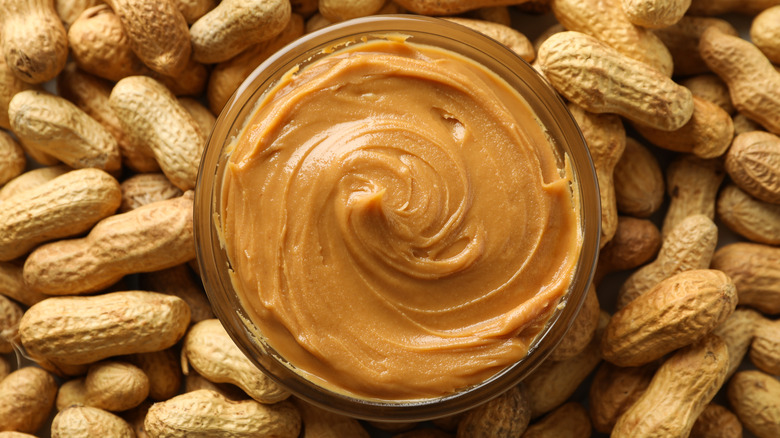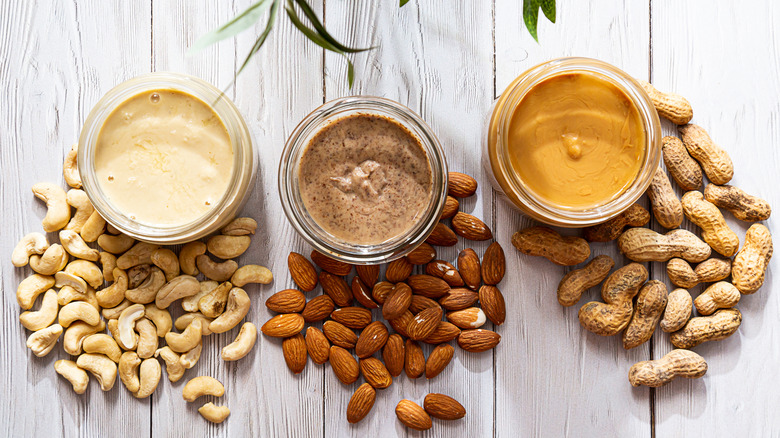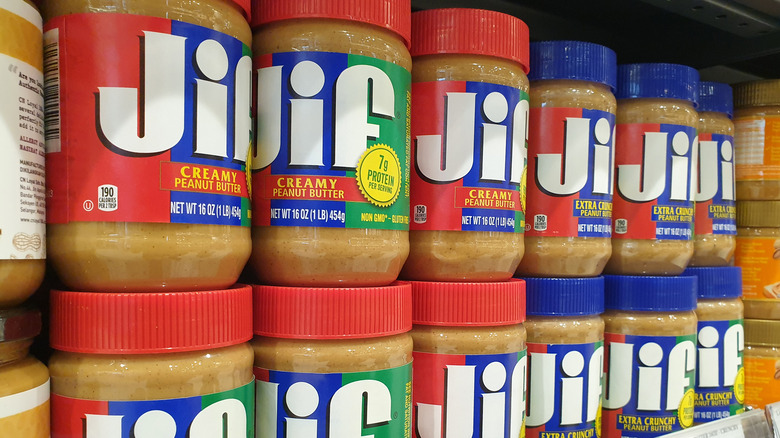The Real Reason Peanut Butter Is So Cheap
When it comes to pantry staples, peanut butter is a pretty common mainstay for many households year-round. Considering the stats it's not surprising. According to findings published by the National Peanut Board, peanut butter consumption was reported at an all-time high in 2021, data indicated that the average person consumed 7.9 pounds of peanut butter within that year alone. Even though mass-produced jars of the stuff only hit grocery store shelves at the turn of the 20th century, over the years peanut butter became a huge hit, per Smithsonian magazine. Today, consumers can choose between crunchy and creamy blends as well as low-sodium and even flavored varieties. Additionally, peanut butter can be found as a main ingredient in a wide range of products, from peanut butter cookies to peanut sauce, curries, and in even more interesting ways you never thought to use.
Whether you prefer to eat it straight out of the jar or paired with ingredients like sriracha, the ever-affordable peanut butter is a nut butter that's here to stay. But what does peanut butter's low price reveal about its ingredients, how it's processed, and its national value?
The price of peanut butter production
According to The Pricer, a consumer products watchdog website, the average lowest price point for a 15-ounce jar of peanut butter totals around roughly $3, with its highest price point at $15. For peanut butter to break ten bucks, it generally has to be at least a 40-ounce jar. And while organic peanut butter usually costs about 30% more than non-organic, that's still a cheaper price tag than you'll find for most conventional kinds of nut butter.
In regards to peanut butter's bargain price, HuffPost shares that a lot of it has to do with the way peanuts are grown. For one, peanuts are legumes that can be grown in many regions throughout the world, so they're never really in short supply. Plus, peanuts grow underground, making them an efficient crop that's less affected by above-ground disturbances like weather or pests. Some peanuts are even disease-resistant, according to the University of Georgia.
On the other hand, a popular peanut butter competitor — for instance, almond butter — requires much more in terms of resources. HuffPost explains that property costs for almond tree fields are about $2,900 per acre compared to $802 per acre of peanut farmland. Almonds also have to be blanched and skinned before they're turned into butter, a process that costs roughly 50 cents per pound. With such high costs of production, it's no wonder why the cost of peanut butter is negligible in comparison.
Is peanut butter worse for you than other nut butters?
Some people might wonder if, generally speaking, the lower price point for peanut butter is indicative of any differences in nutritional value, especially in comparison to other nut butter. The short answer? Not really. According to Healthline, almond butter is marginally healthier than peanut butter — but then again, it really depends on which nutrients you're focusing on. While almond butter has slightly more vitamins, minerals, healthy fats, and fiber than peanut butter, peanut butter contains more protein. All that is to say that in many respects, almond butter and peanut butter have similar nutritional values.
When it comes to quality, the real difference in nutritional value for peanut butter across the board boils down to the ingredients listed on the label. Per Healthline, filler ingredients can turn a healthy nut butter into a sugar-filled spread, so it's something to look out for when picking out any nut butter. Ideally, peanut butter will only contain peanuts and salt, but many brands include fillers like sugars, oils, and emulsifiers.
Looking to avoid fillers but having trouble finding a healthy brand? There's good news. It's actually pretty simple to make homemade peanut butter, and some grocery stores like Whole Foods even have machines that let you do it in-store so you don't have to deal with any cleanup.


